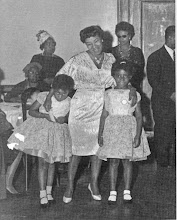Source: www.nytimes.com
A half-century of artmaking by Faith Ringgold is on display at Rutgers University.
I am thinking about this portion of the review published in the Times:
Ringgold’s story quilts are the highlight of her career, combining painting, fabric and storytelling. You can see her masterly talent in “The French Collection Part 1: #2 Wedding on the Seine” (1991), one of a series of story quilts based on trips the artist made with her daughters to Paris, Giverny and Arles in the early 1990s, according to the exhibition catalog.
The trouble is that this statement misrepresents both the truth and what the exhibition catalogue text (not yet published) intends to say. No trips to Paris, Giverny and Arles were made with her daughters in the early 90s. Faith went to these places in the early 90s alone (as we discuss in detail in The Mona Lisa interview (http://www.faithringgold.com/ringgold/guest.htm) and in "The French Collection: Momma Jones, Mommy Faye and Me" in Dan Cameron ed., Dancing at the Louvre: Faith Ringgold's French Collection and Other Story Quilts (http://ucpress.edu/books/pages/8209.php). I maintain in these texts of which I am the author that Faith is integrating her real-life memories of previous trips with her mother and/or daughters to Europe and to Africa in her fictionalization of the travels of Willia Marie, her heroine, who is loosely based on my grandmother and her mother, Willi Posey, or Momma Jones.
Moreover, if you read Faith's autobiograpy, We Flew Over the Bridge (Little Brown, 1995 and Duke UP reissued 2005) you will note exactly what Faith, herself, has to say on this subject, which is slightly different from my projections. She is an individual and so am I.
In my essay in Dancing at the Louvre, I propose that Willia is an imaginary combination of Josephine Baker, Faith and her Mother Willi. And Baker occupies a singular place in the paintings of The French Collection in a portrait of her painted by Willia Marie commemorating Baker's birthday, suggesting that they were contemporaries and friends. The question is this: who among historical figures came closest to going to Europe to live and work in the manner of Willia Marie? The answer is Josephine Baker, the patron saint of this particular series of paintings. Anyhow that's just my opinion but I have an opinion. It would appear that the writer of this review, Benjamin Genocchio has no opinion on the matter because he simply knows so little about it.
Wedding on the Seine (1991) which illustrates this review, the number 2 image in the series, is deeply representative of the incorporation of these multiple themes--Faith's life, the lives of her mothers and daughters, and the lives of black women generally who wanted to become successful artists. The French Collection commemorates that potential and possibility.
Our trips as a family to Europe began in 1961. Grandmother, mother, daughters. 1961, my grandmother was 58, my Mom 31, Barbara and I were 11 and 10 so The French Collection painted in the early and mid 90s reflects upon a collective experience of over 40 years. The complexity of the process is collapsed but why? I don't know but it is frustrating.
Therefore the failure to mention either Faith's design of a deck of cards commemorating the election of Barack Obama and her illustration of the Declaration of Independence, in honor of which the retrospective exhibition is named "A Declaration of Freedom and Independence" fits in with the wilful ignorance of the review. Nonetheless, perhaps if you haven't yet seen the show, you could be happy with it. But I've seen the show.



